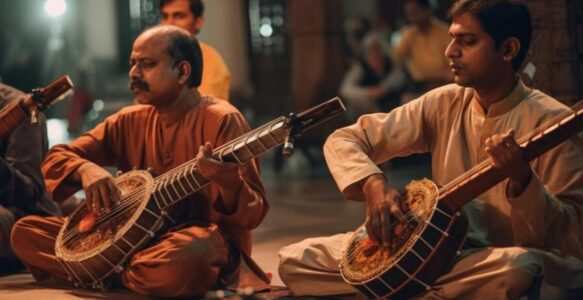Asian traditional music is a vast and diverse tapestry that spans across centuries and continents, reflecting the rich cultural heritage of various Asian countries. From the intricate melodies of Chinese traditional music to the rhythmic beats of Indian classical music, and the haunting sounds of Japanese traditional music, the beauty and diversity of Asian traditional music are truly mesmerizing. In this article, we embark on a journey to explore the origins, instruments, cultural significance, major traditions, cross-cultural influences, and contemporary expressions of Asian traditional music.
Origins of Asian Traditional Music
Asian traditional music has its roots deeply embedded in the history and cultural fabric of each region. The origins of Asian traditional music can be traced back thousands of years, evolving alongside the social, religious, and artistic practices of different civilizations. The music reflects the unique worldview, beliefs, and values of the communities that have nurtured it.
Influenced by factors such as geography, climate, religion, and trade, Asian traditional music exhibits regional variations, each with its distinctive styles and characteristics. Whether it’s the courtly music of China, the devotional ragas of India, or the court music of Japan, each tradition has its own story to tell.
Instruments of Asian Traditional Music
The vibrant sounds of Asian traditional music are brought to life through a wide array of traditional instruments. String instruments like the sitar, guzheng, koto, and gayageum produce enchanting melodies, while percussion instruments like the tabla, taiko drums, and gamelan instruments provide rhythmic accompaniment. Wind instruments such as the bansuri, shakuhachi, and dizi add soulful and expressive tones to the music.
The craftsmanship and design of these instruments reflect the deep cultural significance attached to them. From the intricate carvings on the surface to the choice of materials, each instrument tells a unique story of cultural heritage.
Cultural Significance of Asian Traditional Music
Asian traditional music holds immense cultural significance, playing a central role in various rituals, ceremonies, and cultural expressions. It serves as a medium to connect with the divine, evoke emotions, celebrate life’s milestones, and transmit oral traditions and narratives.
In many Asian cultures, music is intertwined with spirituality and seen as a powerful tool for meditation, healing, and spiritual growth. The melodies and rhythms create a harmonious space where individuals can connect with their inner selves and the world around them.
Major Asian Music Traditions

Asian traditional music encompasses a wide range of musical traditions, each with its unique characteristics and styles. Some of the major Asian music traditions include:
- Chinese Traditional Music: Rooted in a rich history dating back thousands of years, Chinese traditional music showcases a diverse range of instruments, scales, and genres;
- Indian Classical Music: Known for its intricate melodies, improvisation, and elaborate rhythmic structures, Indian classical music is deeply rooted in ancient scriptures and traditions;
- Japanese Traditional Music: With its focus on simplicity, refinement, and capturing the essence of nature, Japanese traditional music, including the elegant sounds of the koto and the meditative shakuhachi flute, has a distinct aesthetic;
- Korean Traditional Music: Korean traditional music, characterized by its vibrant rhythms and unique vocal styles, reflects the country’s deep cultural heritage and regional variations;
- Southeast Asian Traditional Music: Southeast Asia boasts a rich tapestry of traditional music, including the gamelan orchestras of Indonesia, the traditional music of Thailand, and the melodic folk songs of Vietnam.
Each tradition has its own unique musical language, instruments, and performance styles, offering a glimpse into the diverse cultural landscapes of Asia.
Cross-Cultural Influences in Asian Traditional Music
Throughout history, Asian traditional music has experienced cross-cultural influences, shaped by encounters with neighboring regions and colonial powers. The Silk Road, an ancient trade route, played a significant role in facilitating musical exchanges between Asia, the Middle East, and Europe, leading to the fusion of musical styles and instruments.
Colonial influences from European powers brought new instruments, harmonies, and musical structures to Asian traditional music. These influences are particularly evident in Southeast Asian music, where indigenous traditions meld with Western elements.
In the modern era, artists and composers continue to experiment with cross-cultural collaborations, blending traditional Asian music with contemporary genres, and creating innovative and boundary-pushing expressions of music.
Contemporary Expressions of Asian Traditional Music
Asian traditional music is not confined to the past; it continues to evolve and find new expressions in the contemporary world. Revival movements have emerged, driven by a desire to preserve traditional musical forms and instruments. Artists and ensembles actively engage in research, training, and performances to keep these traditions alive.
Contemporary composers draw inspiration from Asian traditional music, incorporating its elements into their compositions. Collaborations between traditional Asian musicians and artists from different genres and backgrounds create exciting fusions that bridge cultural boundaries and captivate global audiences.
The global appreciation and recognition of Asian traditional music have grown, leading to increased opportunities for performances, recordings, and cultural exchange. Asian musicians and ensembles are celebrated on international stages, showcasing the rich tapestry of Asian traditional music to the world.
Conclusion
Asian traditional music embodies the spirit, history, and cultural diversity of the continent. From the ancient melodies that have been passed down through generations to the contemporary expressions that push the boundaries of tradition, Asian traditional music continues to captivate audiences worldwide. It is a testament to the power of music to transcend time, connect cultures, and evoke emotions. As we unveil the beauty and diversity of Asian traditional music, let us celebrate and cherish the harmonies that have echoed across centuries.



